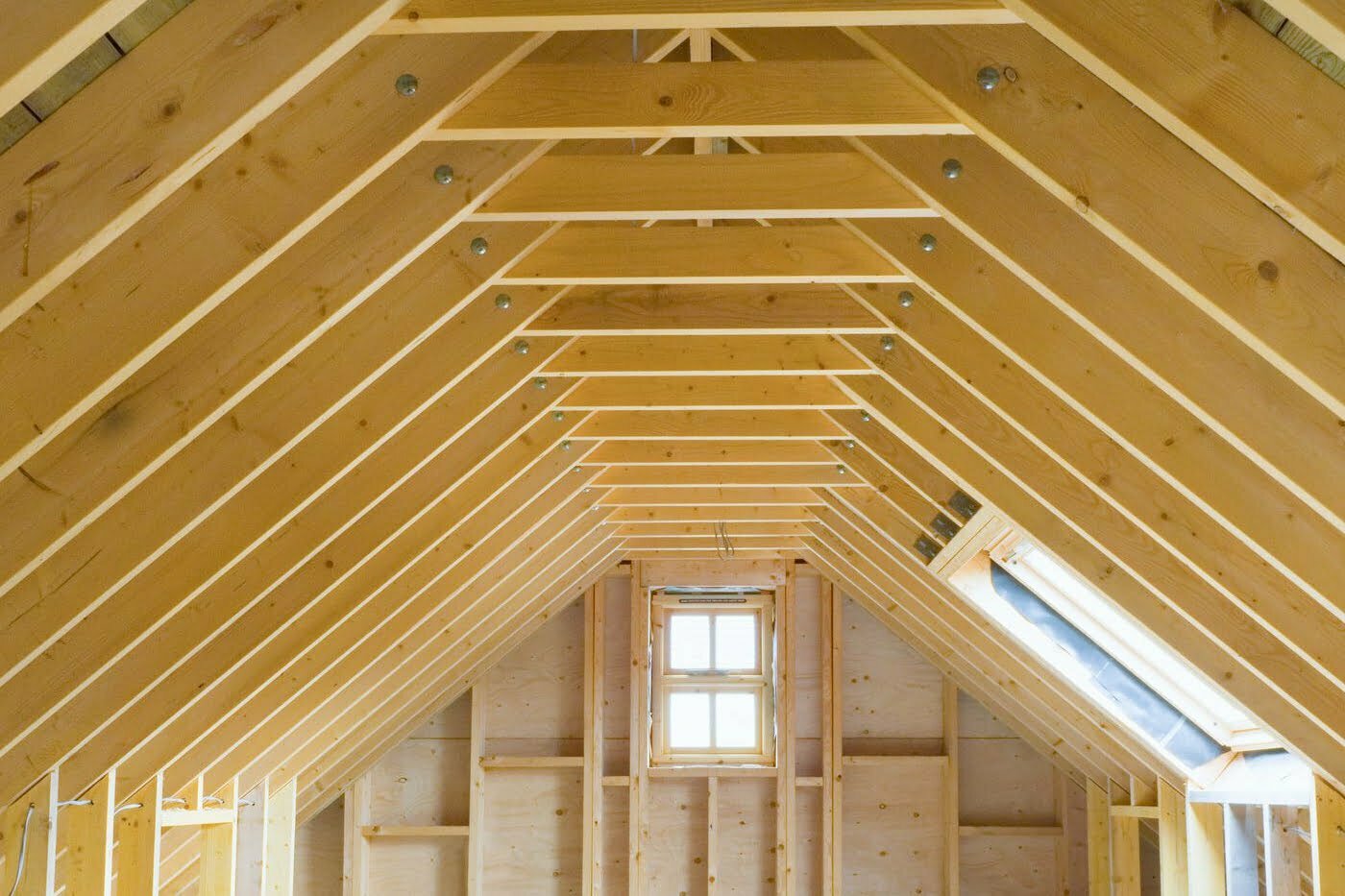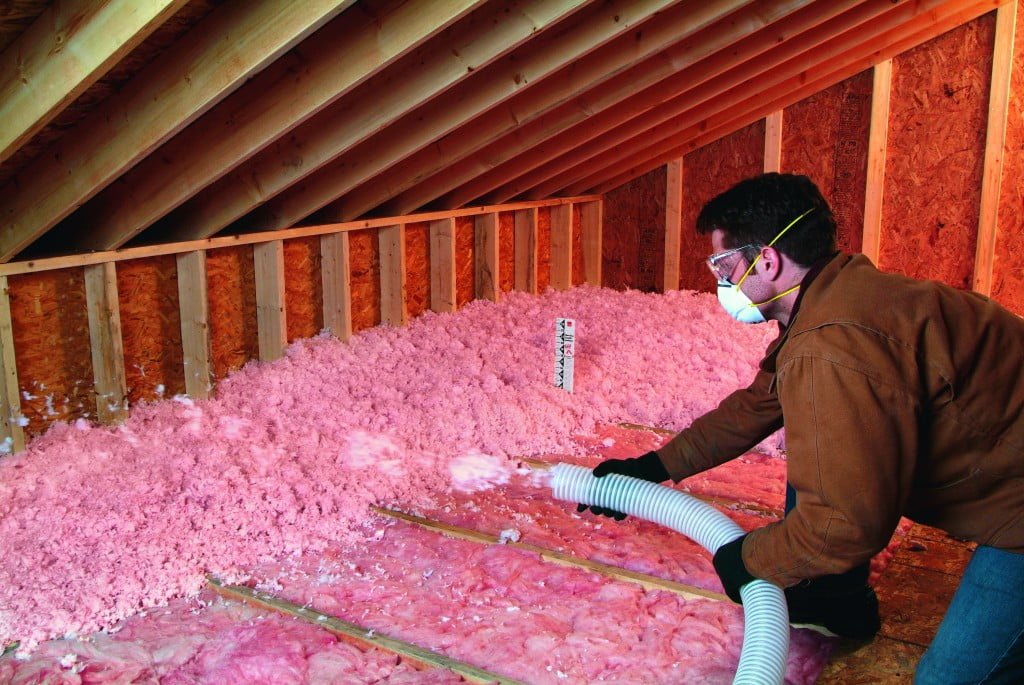Insulation is essential for the energy efficiency, comfort, and overall livability of your home. Among various types of insulation, blown-in insulation has emerged as a popular choice, especially for attic spaces.
If you have too little to no insulation in your attic, the hot summer air will have nowhere to go but into your home, causing temperatures to rise and your air conditioning unit to work harder to cool the space. Thankfully, blown-in insulation in your attic can eliminate these problems, keep your home cooler, and save you big on utility bills.
Understanding Blown-In Insulation
If you’re undertaking a home improvement project that involves insulation, it’s worth considering attic blown-in insulation. This insulation method involves filling stud spaces or wall cavities with insulation material, which drastically improves your home’s thermal resistance.

What is Blown-In Insulation?
Blown-in insulation, as the name suggests, involves blowing insulation material into wall cavities or attic spaces. Insulation contractors use specialized machines to break up and blow loose insulation into your walls or attic, filling up to cover the existing insulation. This insulation method is an excellent way to add insulation to difficult areas like attic bypasses and vent chutes, and it does an excellent job of sealing air leaks.
Different Types of Blown In Insulation: Fiberglass, Cellulose and Mineral Wool
There are three main types of blown-in insulation: fiberglass, cellulose, and mineral wool. Fiberglass insulation, made from molten glass spun into fibers, is light and easy to install. Meanwhile, cellulose-blown insulation, derived primarily from recycled paper, offers fantastic thermal resistance. Lastly, mineral wool is a sturdy insulation material that can withstand high temperatures, making it ideal for fire resistance.
Key Benefits of Using Blown-In Insulation in Your Attic
There are several advantages to using blown-in insulation in your attic. Let’s explore a few of these benefits in detail.

Energy Efficiency and Savings
One of the primary reasons homeowners opt for blown-in insulation is the energy savings fiberglass-blown type of insulation is excellent at sealing air leaks and can contribute to a significant reduction in heating and cooling costs. According to case studies, homeowners can expect to save up to 20% on their energy bills after installing blown-in insulation
Improved Indoor Comfort
Blown-in insulation can dramatically improve indoor comfort by regulating temperatures thanks to its superior insulating properties. This is especially beneficial in older homes, where inconsistent temperatures can be a common issue.
Environmentally Friendly Option
Blown-in insulation is typically made from recycled materials. Therefore, choosing this insulation method contributes to sustainability efforts and is a more environmentally friendly option compared to traditional insulation methods.
The Process of Installing Blown-In Insulation in Your Attic
The attic blown-in insulation process can happen in two stages: preparation and installation. The key to a successful installation is attention to detail during both stages.
Both insulation materials, like cellulose and fiberglass, and tools, such as an insulation calculator and duct tape, play a significant role in the process.
The Need for Professional Installation
Home improvement involving attic insulation should ideally be handled by a professional installer. They have experience dealing with various building materials, managing insulation levels, and safely removing any existing insulation like fiberglass batts. They’re also able to effectively navigate certain areas, addressing air leaks and ensuring vent chutes are adequately sealed.
They also know how to correctly calculate the insulation cost and determine the amount of insulation material needed per square foot, saving you money in the long run.
Installation Costs and ROI
The cost of installing attic insulation will vary based on the insulation material used, the amount needed (determined by the insulation calculator), and the difficulty of access to the attic. However, a properly insulated attic can save a significant amount on heating and cooling costs, making the attic insulation cost a worthy investment.
The Blown-In Insulation Installation Process
At the start, protection for the attic access and other parts of the home is set up. The insulation material is prepared, being fluffed so it expands, creating its thermal resistance. Depending on the existing insulation level and the amount needed for the project, the insulation is then blown onto the attic floor, overlapping any existing insulation to eliminate thermal bridges.

Maintaining Your Blown In Attic Insulation
As important as it is to choose the best insulation material and have it skillfully installed, regular maintenance can keep its thermal resistance optimized. Regular temperature checks can help track the order of thermal resistance and let you know when to add insulation.
The Longevity of Blown-In Insulation
The amount of time that blown-in insulation lasts depends on many factors such as the type of insulation material used – cellulose insulation or fiberglass insulation – and how well it was installed. While cellulose insulation may settle over time, fiberglass insulation tends to last longer. Checking attic insulation after weather extremes can help understand its resilience.
Regular Checkups and Necessary Top Ups
Checking insulation material on a regular basis, especially after major environmental changes, can alert you to issues. Regular maintenance helps keep thermal resistance at its best. This may advise a homeowner to add insulation and even consider different insulation types, like switching from fill fiberglass to spray foam insulation, given the condition of an older home.
Dealing with Potential Issues: Moisture, Pests, and Insulation Removal
A well-insulated attic faces the risk of moisture accumulation, especially without proper ventilation. It can lead to the formation of mold and damage the insulation material. Pests can also cause damage by creating air leaks. Therefore, maintaining cleanliness in the attic space and ensuring that wall cavities and stud spaces are sealed is important. Older homes may require insulation removal and upgrading to spray foam, which provides superior insulation, but this must be done with care.
Blown-In Insulation vs. Other Attic Insulation Options
There are three main options for attic insulation: blown-in insulation, batt and roll insulation, and spray foam insulation. Blown-in insulation, also known as loose-fill, is typically comprised of cellulose blown or fiberglass insulation blown into a stud space using an insulation blower. Batts and rolls are often used for wall cavities and basement insulation made from fiberglass, mineral wool, or cellulose insulation. Spray foam insulation expands and hardens, covering the area effectively.
Cost-effectiveness of Different Insulation Types
Cost is another critical factor to evaluate. Though spray foam insulation offers strong insulation and energy-saving benefits, it is often the most expensive option. When using an insulation calculator, remember to include materials, labor, and clean-up. You can also connect with insulation companies to calculate a free quote for your project.
Typically, fiberglass batts are the least expensive to purchase, but their installation can be labor-intensive, especially in older homes where wall cavities may not be standard. Insulation removal of existing insulation can also add to project costs.
Look to Cincinnati RetroFoam for Your Insulation Project
Whether you’re looking to install blown-in insulation in your attic or you’re unsure which insulation type works best, Cincinnati RetroFoam is here to help. Since 2015, we’ve offered premium foam insulation to homeowners that isn’t available anywhere else. Our mission is to provide impeccable service and give our best at every job to give homeowners lasting comfort and long-term savings.
We offer a range of insulation services, including blown-in insulation, injection foam, and spray foam. We work on existing homes, new construction, pole barns, and commercial properties. Whatever your insulation needs are, we’re here to help. We also offer financing options if you’re looking for ways to manage insulation costs. Let us serve as your trusted partner for your upcoming insulation project. Contact us today to get your free quote.
Frequently Asked Questions
Is blown-in attic insulation worth it?
Yes, blown-in attic insulation is a smart choice for homeowners looking to improve the comfort of their home and lower utility bills. When installed properly by professionals, this insulation lasts for years and helps regulate the temperature of your home.
What is the life expectancy of blown-in insulation?
Blown-in insulation can last 20-30 years when installed properly. It’s important to regularly check your insulation, particularly after extreme weather, to ensure it’s still properly functioning.
Is it worth replacing blown-in insulation?
If you live in an older home, it’s worth checking with professionals to see if the insulation needs replaced. Replacing old insulation can lower utility bills, increase your property value, and improve the comfort of your home.
